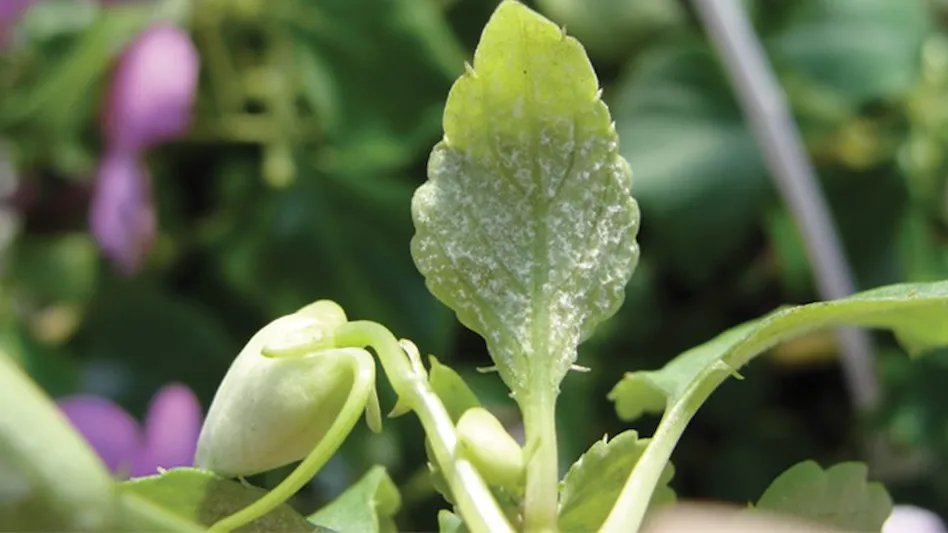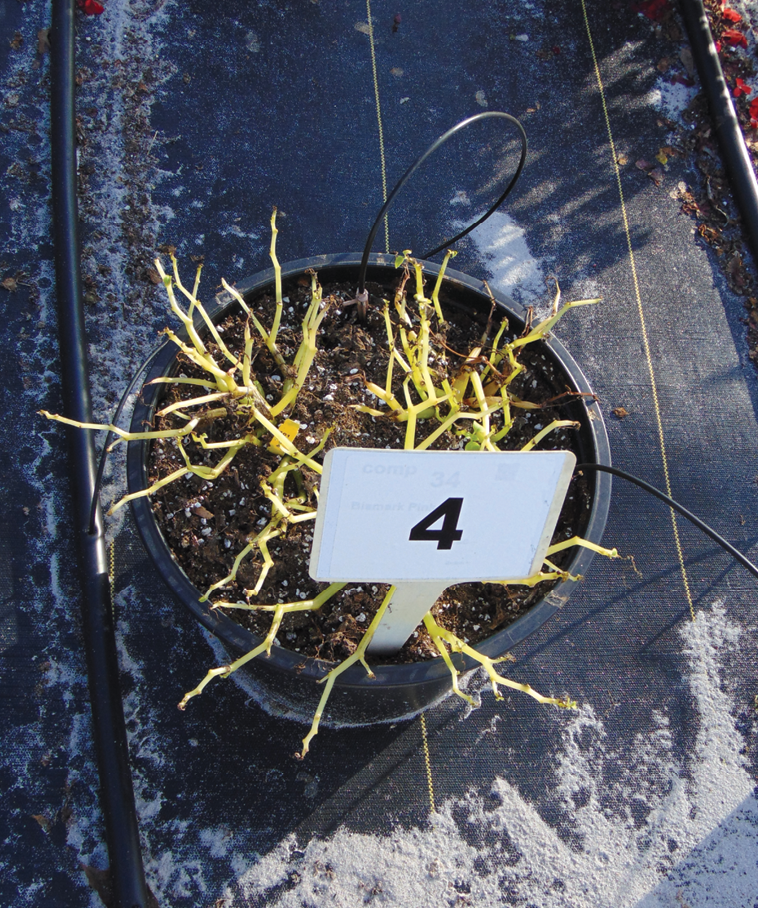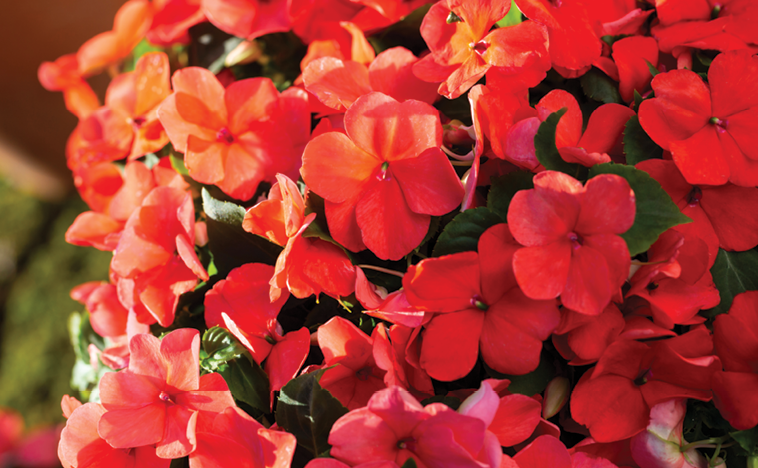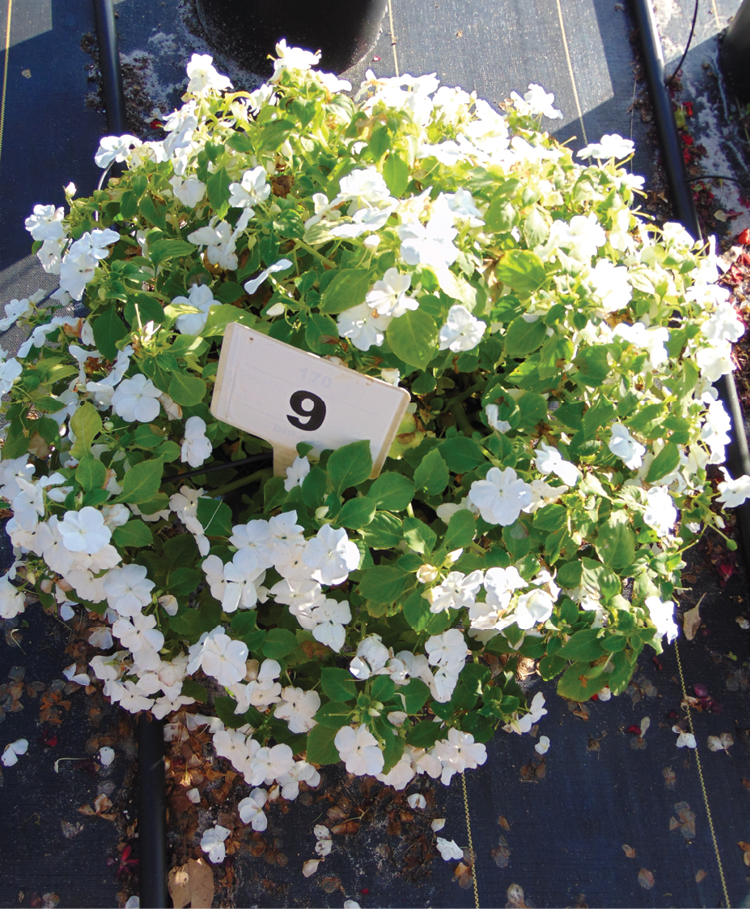

One of the most popular bedding plants across the globe became a rare commodity when impatiens downy mildew went rampant in 2011. The disease, caused by the pathogen Plasmopara obducens, decimated the impatiens market and has had a lasting impact on the production and successful use of impatiens and many other crops.
Downy mildew diseases are notoriously difficult to control because of a few particular factors that ease its spread. The reproductive cycle can occur within a short period of time under the right environmental conditions.
They are also known for producing sporangia, which contain mobile zoospores that are capable of starting new infections.
“The disease can progress very quickly in some plant systems,” says Nancy Rechcigl, technical services manager for ornamentals at Syngenta. “In some instances, the disease can become systemic, leading to recurrent infections or plant death.”

Non-treated impatiens at 10 weeks
Rotation and the “sandwich” approach
Recent innovations in plant protection products and genetics provide the tools needed to successfully produce impatiens in the greenhouse and grow them in the landscape.
Still, practicing good resistance management is critical to preserve plant protection chemistries and crop genetics. Downy mildew fungi in particular are known to develop resistance very easily when exposed to a single active ingredient over an extended period of time, Rechcigl says. To avoid developing resistance issues, it is important to incorporate at least two and ideally three products with different modes of action into a rotation for each target problem.
Fungicides that are effective on downy mildews come from FRAC groups 4, 21, 40, 43, 45 and 49. These specifically target oomycete diseases, including downy mildew and Phytophthora. Growers should try to select products from these FRAC groups and put them in a rotation. Rechcigl also suggests incorporating fungicides from FRAC groups 7 and 11 as well, because they include broad-spectrum activity fungicides. A crop that is susceptible to downy mildew isn’t just going to be fighting downy mildew. Mixing in these fungicides allows growers to protect against downy mildew while still covering other diseases like Botrytis and fungal leaf spots.
“Ideally, a program should include a combination of products with systemic activity as well as contact or translaminar activity,” Rechcigl says. “A well-structured program will consider how best to utilize the products’ strengths and leverage modes of action at times when they will provide the maximum benefit.”
Rotating modes of action is important, but another key to successful rotation is using products in a particular order. Even for new disease-tolerant and resistant genetics, Rechcigl recommends implementing a rotation program that utilizes a “systemic sandwich” approach.
“With this approach, systemic fungicides are applied as a drench at transplant or at the beginning of production and again prior to shipping,” says Rechcigl. “Other fungicides with translaminar activity should be applied as sprays in between. The use of systemic products as a drench prior to shipping provides extended protection in the landscape for the consumer, which maximizes garden performance. The sprays applied between the drenches are part of a resistance management strategy to take the pressure off the control provided by the drench.”
Rechcigl says that Segovis® fungicide, launched by Syngenta in 2016, currently offers the longest residual activity out of all the systemic products, which makes it a particularly good fit for “systemic sandwich” rotation programs. Also, Segovis has a unique mode of action and can be applied as a drench for long-lasting control of downy mildew. Its novel active ingredient in FRAC group 49 can help diversify treatments, which is ideal for rotation programs. Mural® and Micora® fungicides can be applied as sprays in between to offer translaminar activity and continued control of downy mildews, as well as other diseases.

Practical experience
Jeff Walls, head grower at Kube-Pak, in Allentown, N.J., has experience using Segovis as a preventive measure for downy mildew. Kube-Pak produces plugs and rooted cuttings for greenhouse growers, as well as finished plants for garden centers and landscapers in 20 acres under cover and six acres of outside growing area. Walls applies the fungicide in the spring to coleus, agastache, ornamental cabbage and kale.
“It’s become protocol,” he says. “In 2017, we lost 40% of our agastache crop to downy mildew, but we didn’t have any issues with it in 2018. We sprayed Segovis preventively and there was no loss of the crop. When we saw signs of downy mildew on seed and vegetative varieties of coleus, we drenched with Segovis at the high rate of 2.4 oz/100 gal. It cleared right up and we were able to ship the crop seven days later. That may be my first time ever seeing something clear up like that and still be able to ship.”
In addition to the ability to clear plants of disease, the level of preventive control he’s seen has allowed Walls to reduce chemical usage at Kube-Pak.
“With other fungicides we could control outbreaks but would have to apply a lot of chemicals to clear the crops of disease,” he says. “We are using less chemicals now because of the improved chemistries in Mural and Segovis.”

Resistant varieties
Better fungicides and smart rotations can reduce the impact of downy mildew. Growers also are fighting back by using new resistant varieties.
“No doubt, impatiens downy mildew has been one of the most significant diseases to affect the ornamental production market in the past two decades,” Rechcigl says. “We did see a big drop in impatiens production in 2013 and again in 2014, but we are starting to see this turn around.”
New innovations in plant protection products and resistant genetics have created optimism about the future of impatiens for the garden market.
Imara™ XDR from Syngenta Flowers is billed as the first Impatiens walleriana with a high degree of resistance to downy mildew. It performed well in independent trials in North America and Europe, including trials in 2017 and 2018 at Cornell University’s Long Island Horticultural Research and Extension Center.
Even though these new varieties are resistant, that doesn’t mean growers can completely ignore disease pressure.
“Resistance management is just as important with plant genetics that are bred for tolerance to a disease as it is for preserving new chemistry,” Rechcigl says.
Over time, new strains of the pathogen will evolve that will overcome the plant’s tolerance or resistance. This unfortunate factor tends to occur most frequently in oomycetes.
While disease pressure within production may appear to be low and manageable with resistant varieties alone, the real success is if the plants can maintain their landscape performance for the season under disease pressure, year after year. A fungicide program can help preserve genetic resistance and depending upon the product and timing, help ensure optimum landscape performance.
“Resistant varieties give us another tool to use to manage or avoid a problem and achieve a successful outcome,” Rechcigl says. “When they are used in a program with effective products, you have the greatest chance of success.”
To learn more: GreenCastOnline.com/Segovis

Explore the July 2019 Issue
Check out more from this issue and find you next story to read.
Latest from Greenhouse Management
- Passion grows progress
- Registration opens for Darwin Perennials Day
- U.S. Department of Labor finalizes farmworker protection rule
- Azo Root is now available from Harrell’s
- Bidens ferulifolia Blazing Glory
- Rob Hanifin joins Ridder North America as product specialist for climate screens
- The importance of measuring light
- Spigelia marilandica





